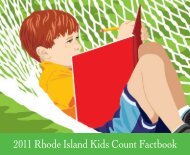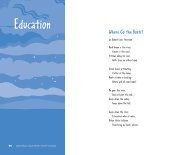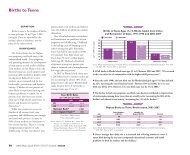2010 Rhode Island Kids Count Factbook
2010 Rhode Island Kids Count Factbook
2010 Rhode Island Kids Count Factbook
Create successful ePaper yourself
Turn your PDF publications into a flip-book with our unique Google optimized e-Paper software.
English Language Learners<br />
DEFINITION<br />
English Language Learners is the<br />
percentage of all public school children<br />
(pre-kindergarten through grade 12)<br />
who are receiving English as a second<br />
language services or bilingual education<br />
services in <strong>Rhode</strong> <strong>Island</strong> public schools.<br />
SIGNIFICANCE<br />
English Language Learner (ELL)<br />
students are among the fastest growing<br />
populations in public schools, especially<br />
in elementary schools. 1,2 Many ELL<br />
students face challenges to succeeding in<br />
school, including poverty, lack of access<br />
to health care, low parental education<br />
levels and discrimination or racism. 3,4<br />
ELL students are challenged to<br />
simultaneously learn English and<br />
succeed academically. 5 ELL students in<br />
the same age group have many differing<br />
levels of reading, math, and writing<br />
proficiency, both in English and in their<br />
native languages. 6 Successful ELL<br />
education programs are adaptable to<br />
student needs, use ongoing assessments<br />
of student progress, and provide<br />
educators with ongoing professional<br />
development. Bilingual education<br />
programs can be particularly effective<br />
with ELL students. 7,8,9<br />
ELL students and children in<br />
immigrant families are more likely to be<br />
concentrated in schools that are underresourced,<br />
large, serve high proportions<br />
of minority students and located in<br />
high poverty communities. 10,11,12 In the<br />
2008-2009 school year in <strong>Rhode</strong><br />
<strong>Island</strong>, 85% (6,062) of all ELL students<br />
lived in low-income families, and 75%<br />
(5,375) lived in the core cities. 13<br />
Studies show that ELL students<br />
believe that school prepares them to<br />
get ahead and that studying hard is<br />
important to succeed. Most hope to go<br />
to college. 14 Schools play a critical role<br />
in helping ELL students transition to<br />
the culture of the U.S. and supporting<br />
their academic success. 15,16<br />
In the 2008-2009 school year in<br />
<strong>Rhode</strong> <strong>Island</strong>, ELL students in <strong>Rhode</strong><br />
<strong>Island</strong> public schools spoke 80 different<br />
languages; the majority (74%) spoke<br />
Spanish, 7% spoke Asian languages, 7%<br />
spoke Creole or Patois, 4% spoke<br />
Portuguese, and 1% spoke African<br />
languages. 17<br />
Twenty-eight percent of ELL<br />
students were enrolled in a bilingual<br />
program and 72% were enrolled in an<br />
English as a second language (ESL)<br />
program. Public schools in Central<br />
Falls, Cranston, East Greenwich,<br />
Providence and the International<br />
Charter School offered bilingual<br />
programs during the 2008-2009<br />
English Language Learners’ Mathematics and Reading Proficiency, 2009<br />
English Language Learner Students All Students<br />
100%<br />
90%<br />
80%<br />
70%<br />
60%<br />
67%<br />
70%<br />
62%<br />
50%<br />
54%<br />
40%<br />
30%<br />
20%<br />
10% 18%<br />
22%<br />
9%<br />
16%<br />
0%<br />
4th Grade Math 4th Grade Reading 8th Grade Math 8th Grade Reading<br />
Source: <strong>Rhode</strong> <strong>Island</strong> Department of Elementary and Secondary Education, New England Common Assessment Program<br />
100 (NECAP), October 2009.<br />
90<br />
80<br />
◆ Nationally and in <strong>Rhode</strong> <strong>Island</strong>, ELL students score significantly lower on<br />
70<br />
standardized 60 tests than their peers. 19,20 In 2009 in <strong>Rhode</strong> <strong>Island</strong>, 22% of fourth-grade<br />
50<br />
ELL 40 students scored at or above proficiency in reading, compared to 67% of fourth<br />
30<br />
graders statewide. 21<br />
20<br />
10<br />
0<br />
◆ Nationally and in <strong>Rhode</strong> <strong>Island</strong>, the achievement gap between ELL students and all<br />
students widens between elementary and middle school. 22,23 In 2009 in <strong>Rhode</strong> <strong>Island</strong>,<br />
16% of eighth-grade ELL students scored at or above proficiency in reading, compared<br />
to 70% of eighth graders statewide. 24<br />
English Language Learners Mathematics and Reading Proficiency Trends<br />
◆ Between 2008 and 2009, the percentage of ELL students proficient in reading increased,<br />
while the percentage who were proficient in math fell. The achievement gap in math<br />
between ELL students and other students grew by three percentage points in 2009. 25,26<br />
school year. 18<br />
◆ Best practices to increase the academic achievement of ELL students include tailoring<br />
instructional practices to students’ needs, understanding and using demographic<br />
and assessment data, employing highly skilled teachers and leaders, collaboration and<br />
shared accountability among educators and school administrators, and implementing<br />
programs with a dual focus on English proficiency and course content. 27<br />
130 <strong>2010</strong> <strong>Rhode</strong> <strong>Island</strong> KIDS COUNT <strong>Factbook</strong> / Education






